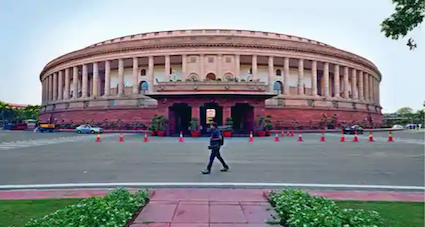The artist Anish Kapoor’s piece in The Guardian, dated June 4, (“Modi’s bulldozing of parliament shows him as the architect of a Hindu Taliban”), is outrageous, if somewhat predictable. Across both international media and social media, you witness the airing of self-righteousness and performative opinions, with guns ubiquitously trained on India and its government, even as India battles an unprecedented and monstrous second wave of Covid-19.
Firstly, as New Delhi’s Central Vista Redevelopment Project acquires shape, its iconic Parliament building is not going to be demolished, nor are its elegant North and South Blocks, which accommodate the offices of India’s central government. The latter will eventually house the National Museum, after being upgraded, according to heritage standards. Kapoor, activists, the media, and our native Mrs Jellybys need to register these facts. They clearly have not.
India’s Parliament building, beautiful and strong in its time, is alas, decrepit now. It is over a hundred years old, creaky, precarious, not earthquake-proof, and in a state of rapid disintegration. There are wire meshes across the ceiling to prevent chunks from falling on our unsuspecting leaders’ heads, and, God forbid, grievously wounding them. It is dank, malodorous, and uninhabitable. It has been this way, as I recall, since 1999, when I first started attending the Parliament with the leaders I advised. For all its external beauty, the Parliament house indoors, is, verily, Bleak House.
In 2012, it was the UPA government which mooted the idea of a sorely-needed new, modern Parliament building and was supported across party lines. When the BJP government followed up, the nectar swiftly morphed into poison. We need more consistency and maturity in a public debate on what the Delhi High Court has rightly called, a project of “national importance.”
The new Parliament building of the Central Vista project, as the temple of our democracy, is slated to provide the representatives of our people with a salubrious and state-of-the-art office and meeting space, engineered with modern technology to be earthquake-proof and to last for the next 250 years. The new central government offices flanking Rajpath will save India’s government several crores in rent per year and the total allocation for the project is in the ballpark of Rs 13,450 crore ($1.8 billion), to be spent over five years.
In times of scarcity it generates employment for workers, who, contrary to fallacious media reports, are well-housed on the site, and follow Covid-19 protocols. The ranters and ravers, cobbling together letters of protest which go nowhere, on the lawns of Delhi’s elegant clubs, might think of tangible ways of generating crucial employment for the underprivileged sections of society, during an economic downturn, as the Central Vista project does.
The unfounded and jejune allegation that the expenditure on the Central Vista project during a pandemic is at the expense of the health budget has been busted. A whopping Rs 35,000 crore ($4.82 billion) has been earmarked for vaccines, and the Ministry of Health’s budget has been scaled up.
Kapoor’s wild rantings hit a new low when he falsely attributes his fabricated demolition of the Parliament house, and North and South Blocks to the Indian government’s dislike of anything Islamic. He calls this a process of “de-Islamisation” and hurls expletives at India’s Prime Minister Narendra Modi. His charge of de-Islamisation is pure hallucination.
If India’s government was allergic to Islamic architecture, it would have demolished Humayun’s Tomb, Jama Masjid, Qutub Minar, Safdarjung’s Tomb, Lodhi Gardens, Purana Qila, the Red Fort and other lovely Islamic monuments across Delhi, which it assiduously maintains for viewing pleasure, and the aesthetic experience of millions of Delhi residents and tourists.
Kapoor does not stop there. He leaps from one ad hominem fallacy to another, and his averments are predicated on a map of misreading. The Parliament building and North and South Blocks are not built on an Islamic architectural model as Kapoor erroneously states. Elements of architecture from all faiths and styles are felicitously incorporated into these buildings, and there certainly is a notable Palladian influence.
But Edwin Lutyens and Herbert Baker might well have drawn inspiration from the magnificent Hindu temples of Chausathi Yogini, which date back to the 9th century AD in Madhya Pradesh, Chhattisgarh and Odisha. (I believe they did, the resemblance is so striking). Kapoor has failed to spot this pretty obvious model and inspiration: As a sculptor, you would think he would be one of the first to notice.
Finally, his naive yet malicious assertion that these are the machinations of a Hindu Taliban fall abysmally flat. The phrase Hindu Taliban is a contradiction in terms: There can never be a Hindu Taliban. In its essence, Sanatana Dharma, which the Hindus follow, is everything that the Taliban is not.
(This piece by Oopalee Operajita first appeared in Indian Express and reproduced here with gratitude).
(Panchmukha is interesting content floating on internet, brought by NewsBred for its readers. They don’t necessarily reflect our view but makes our platform diverse.)


